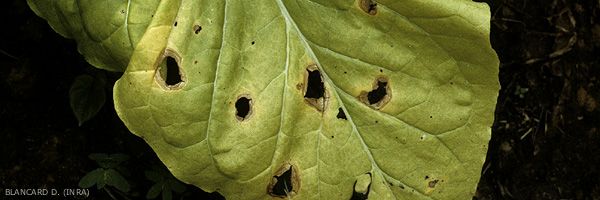
Thanatephorus cucumeris
(A. B. Frank) Donk (1956)
Damping-off, Sore shin, Target spot
- classification : Fungi, Basidiomycota, Agaricomycetes, Incertae sedis, Cantharellales, Ceratobasidiaceae
- English names: damping-off, sore shin, target spot
Numerous studies have been carried out to characterise the strains of Thanatephorus cucumeris (anamorph Rhizoctonia solani). Among the studied criteria of differentiation were their anastomosic affinities which established 11 anastomosis groups (AG). Our knowledge of the strains infecting tobacco is still limited. From what we know two trends can be identified:
- Several strains belonging to different anastomosis groups are able to cause damping-off and tobacco collar cankers. This is the case of strains belonging to AG-4 in Zimbabwe, Italy and the USA (also to AG-1 in the latter), to AG-1 and AG-2 in France and to AG-2 and AG-5 in Italy;
- Only strains belonging to AG-3 cause leaf spots. They have been characterised in the USA, Canada, Zimbabwe and South Africa. Some of these strains also cause symptoms on below-ground organs.
The few strains belonging to AG-1 and AG-2 observed in France on collars and roots, normally show different parasitic specialisations:
- AG-2, subdivided into two subgroups, may soon be divided into three and includes strains which are relatively specialised in cruciferous plants (AG-2-1) or corn and sugar beet (AG-2-2) ;
- AG-1, incorporates many highly polyphagous strains attacking dicotyledons, but also the foliar sheaths of graminaceous plants.
Thanatephorus cucumeris is globally widespread. It is able to infect many different hosts (over a hundred), including all cultivated Solanaceae. On tobacco this soil fungus is best known to cause damping-off in nurseries (figure 1 and 2) and collar cankers after planting (figure 3). Since the 1980’s, leaf symptoms ("target spot") have been observed in several states of USA, in Zimbabwe, South Africa and Canada. Previously the disease had been described in Brazil, Costa Rica and probably in Bulgaria.
In France, this fungus causes damage in traditional nurseries and collar cankers in the field. In addition, it is frequently observed on damaged roots of mature tobacco, alone or in combination with Thielaviopsis basicola. Its parasitic role on mature plants is not well defined. It seems obvious that it is a marker of poorly rotated soils having had many tobacco or other susceptible crops. It seems to be able to induce root damage when the soil inoculum level is very high or when environmental conditions are favourable. In general, considering the frequency of occurrence on tobacco one should not underestimate this fungus.
U.S. situation
In the USA the disease is common in tobacco greenhouses. It occurs also in tobacco fields where incidence is highly related to environmental conditions. In the flue-cured production areas incidence appears to be random and varies from year to year. In the Burley production areas the disease seems to occur in the same fields year after year.
(Mina Mila - North Carolina State University)
CHINA situation
In China the target spot disease is common in later season in fields. It mainly occurs in north, including Liaoning, Jilin and Heilongjiang province. In 2005 and 2006, the disease occurred seriously in Dandong and north flue-cured growing areas of Liaoning province, and in 2011 it occurred in Guangxi province. Incidence was highly related to local environmental conditions, and varied every year.
The pathogens causing tobacco sore shin and target spot in Guangxi province in China belong to AG-2 and AG-4 anastomosis groups, those causing target spot disease in Liaoning, Jilin and Heilongjiang province belong to AG-3.
(Jing Wang - Tobacco Research Institute, Chinese Agricultural Academy Science)





